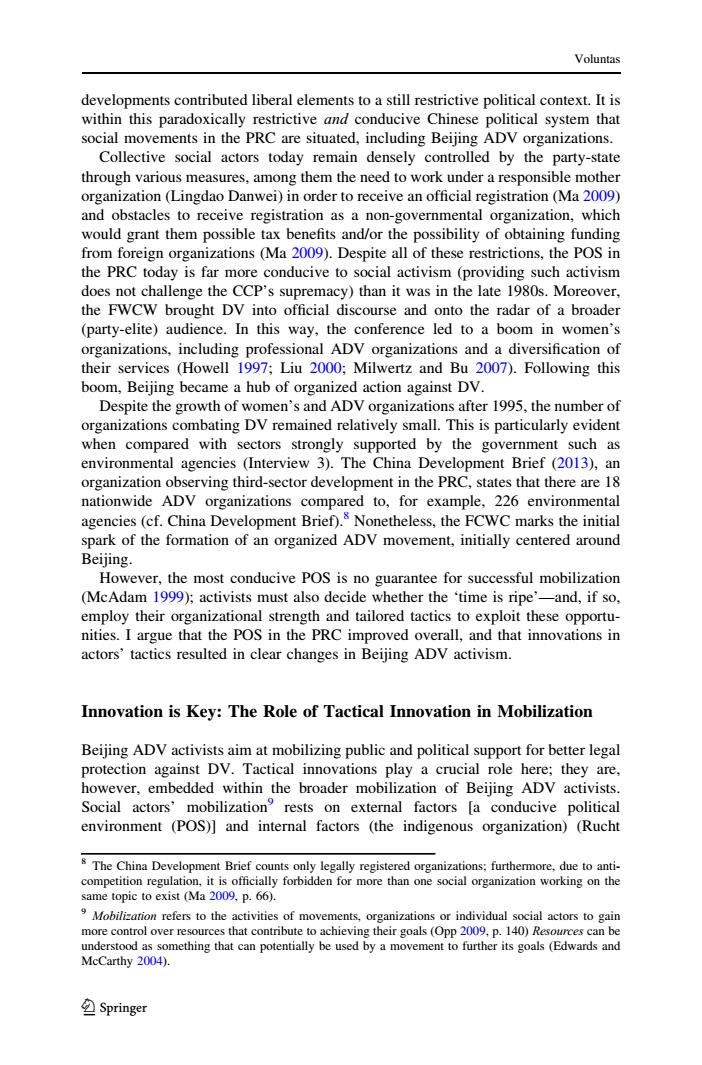正在加载图片...

Voluntas developments contributed liberal elements to a still restrictive political context.It is within this paradoxically restrictive and conducive Chinese political system that social movements in the PRC are situated,including Beijing ADV organizations. Collective social actors today remain densely controlled by the party-state through various measures,among them the need to work under a responsible mother organization(Lingdao Danwei)in order to receive an official registration(Ma 2009) and obstacles to receive registration as a non-governmental organization,which would grant them possible tax benefits and/or the possibility of obtaining funding from foreign organizations(Ma 2009).Despite all of these restrictions,the POS in the PRC today is far more conducive to social activism (providing such activism does not challenge the CCP's supremacy)than it was in the late 1980s.Moreover, the FWCW brought DV into official discourse and onto the radar of a broader (party-elite)audience.In this way,the conference led to a boom in women's organizations,including professional ADV organizations and a diversification of their services (Howell 1997;Liu 2000;Milwertz and Bu 2007).Following this boom,Beijing became a hub of organized action against DV. Despite the growth of women's and ADV organizations after 1995,the number of organizations combating DV remained relatively small.This is particularly evident when compared with sectors strongly supported by the government such as environmental agencies (Interview 3).The China Development Brief (2013),an organization observing third-sector development in the PRC,states that there are 18 nationwide ADV organizations compared to,for example,226 environmental agencies(cf.China Development Brief).Nonetheless,the FCWC marks the initial spark of the formation of an organized ADV movement,initially centered around Beijing. However,the most conducive POS is no guarantee for successful mobilization (McAdam 1999);activists must also decide whether the 'time is ripe'-and,if so, employ their organizational strength and tailored tactics to exploit these opportu- nities.I argue that the POS in the PRC improved overall,and that innovations in actors'tactics resulted in clear changes in Beijing ADV activism. Innovation is Key:The Role of Tactical Innovation in Mobilization Beijing ADV activists aim at mobilizing public and political support for better legal protection against DV.Tactical innovations play a crucial role here;they are, however,embedded within the broader mobilization of Beijing ADV activists. Social actors'mobilization rests on external factors [a conducive political environment (POS)]and internal factors (the indigenous organization)(Rucht s The China Development Brief counts only legally registered organizations:furthermore,due to anti- competition regulation,it is officially forbidden for more than one social organization working on the same topic to exist (Ma 2009.p.66). Mobilization refers to the activities of movements,organizations or individual social actors to gain more control over resources that contribute to achieving their goals (Opp 2009,p.140)Resources can be understood as something that can potentially be used by a movement to further its goals(Edwards and McCarthy 2004). 2Springerdevelopments contributed liberal elements to a still restrictive political context. It is within this paradoxically restrictive and conducive Chinese political system that social movements in the PRC are situated, including Beijing ADV organizations. Collective social actors today remain densely controlled by the party-state through various measures, among them the need to work under a responsible mother organization (Lingdao Danwei) in order to receive an official registration (Ma 2009) and obstacles to receive registration as a non-governmental organization, which would grant them possible tax benefits and/or the possibility of obtaining funding from foreign organizations (Ma 2009). Despite all of these restrictions, the POS in the PRC today is far more conducive to social activism (providing such activism does not challenge the CCP’s supremacy) than it was in the late 1980s. Moreover, the FWCW brought DV into official discourse and onto the radar of a broader (party-elite) audience. In this way, the conference led to a boom in women’s organizations, including professional ADV organizations and a diversification of their services (Howell 1997; Liu 2000; Milwertz and Bu 2007). Following this boom, Beijing became a hub of organized action against DV. Despite the growth of women’s and ADV organizations after 1995, the number of organizations combating DV remained relatively small. This is particularly evident when compared with sectors strongly supported by the government such as environmental agencies (Interview 3). The China Development Brief (2013), an organization observing third-sector development in the PRC, states that there are 18 nationwide ADV organizations compared to, for example, 226 environmental agencies (cf. China Development Brief).8 Nonetheless, the FCWC marks the initial spark of the formation of an organized ADV movement, initially centered around Beijing. However, the most conducive POS is no guarantee for successful mobilization (McAdam 1999); activists must also decide whether the ‘time is ripe’—and, if so, employ their organizational strength and tailored tactics to exploit these opportunities. I argue that the POS in the PRC improved overall, and that innovations in actors’ tactics resulted in clear changes in Beijing ADV activism. Innovation is Key: The Role of Tactical Innovation in Mobilization Beijing ADV activists aim at mobilizing public and political support for better legal protection against DV. Tactical innovations play a crucial role here; they are, however, embedded within the broader mobilization of Beijing ADV activists. Social actors’ mobilization9 rests on external factors [a conducive political environment (POS)] and internal factors (the indigenous organization) (Rucht 8 The China Development Brief counts only legally registered organizations; furthermore, due to anticompetition regulation, it is officially forbidden for more than one social organization working on the same topic to exist (Ma 2009, p. 66). 9 Mobilization refers to the activities of movements, organizations or individual social actors to gain more control over resources that contribute to achieving their goals (Opp 2009, p. 140) Resources can be understood as something that can potentially be used by a movement to further its goals (Edwards and McCarthy 2004). Voluntas 123